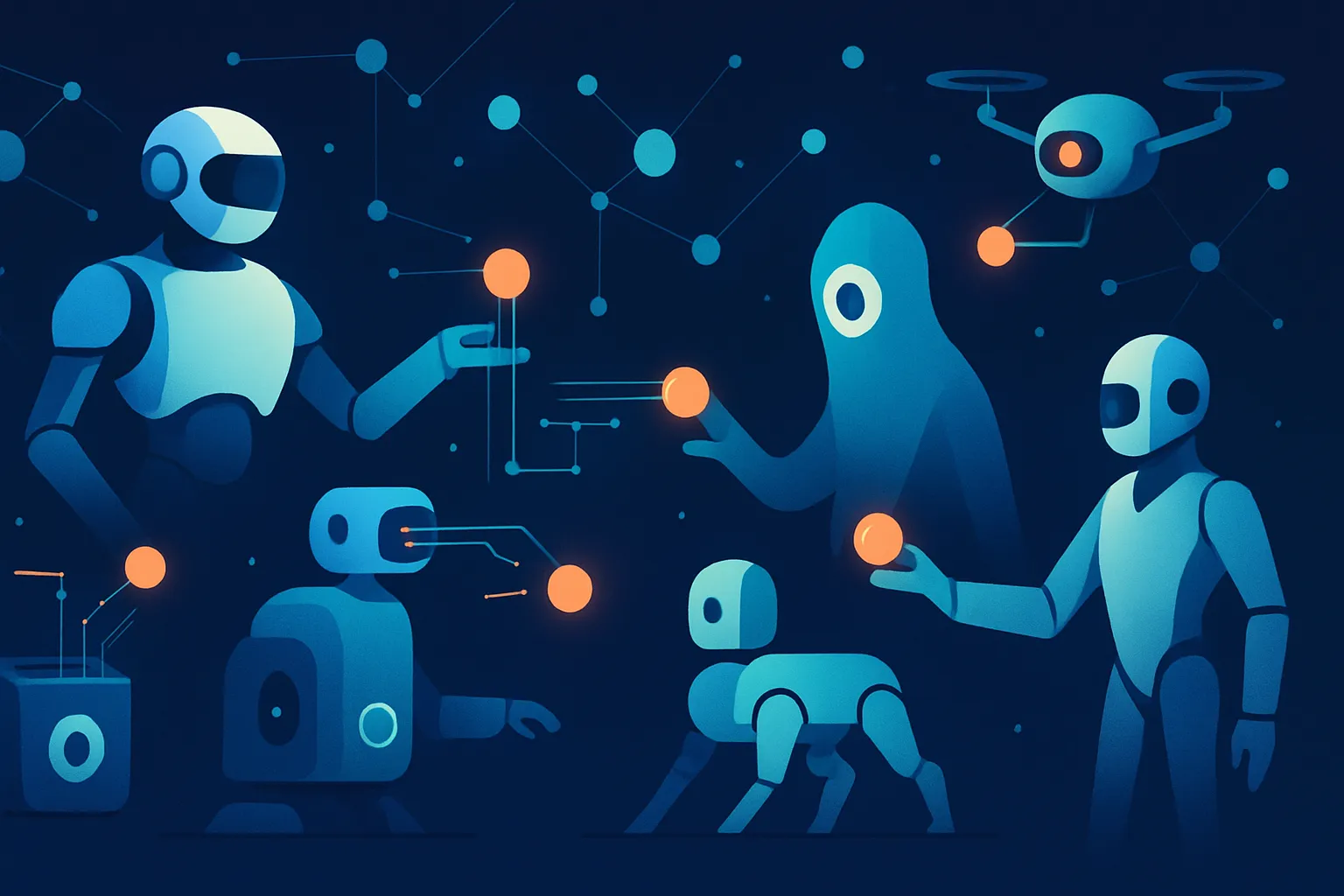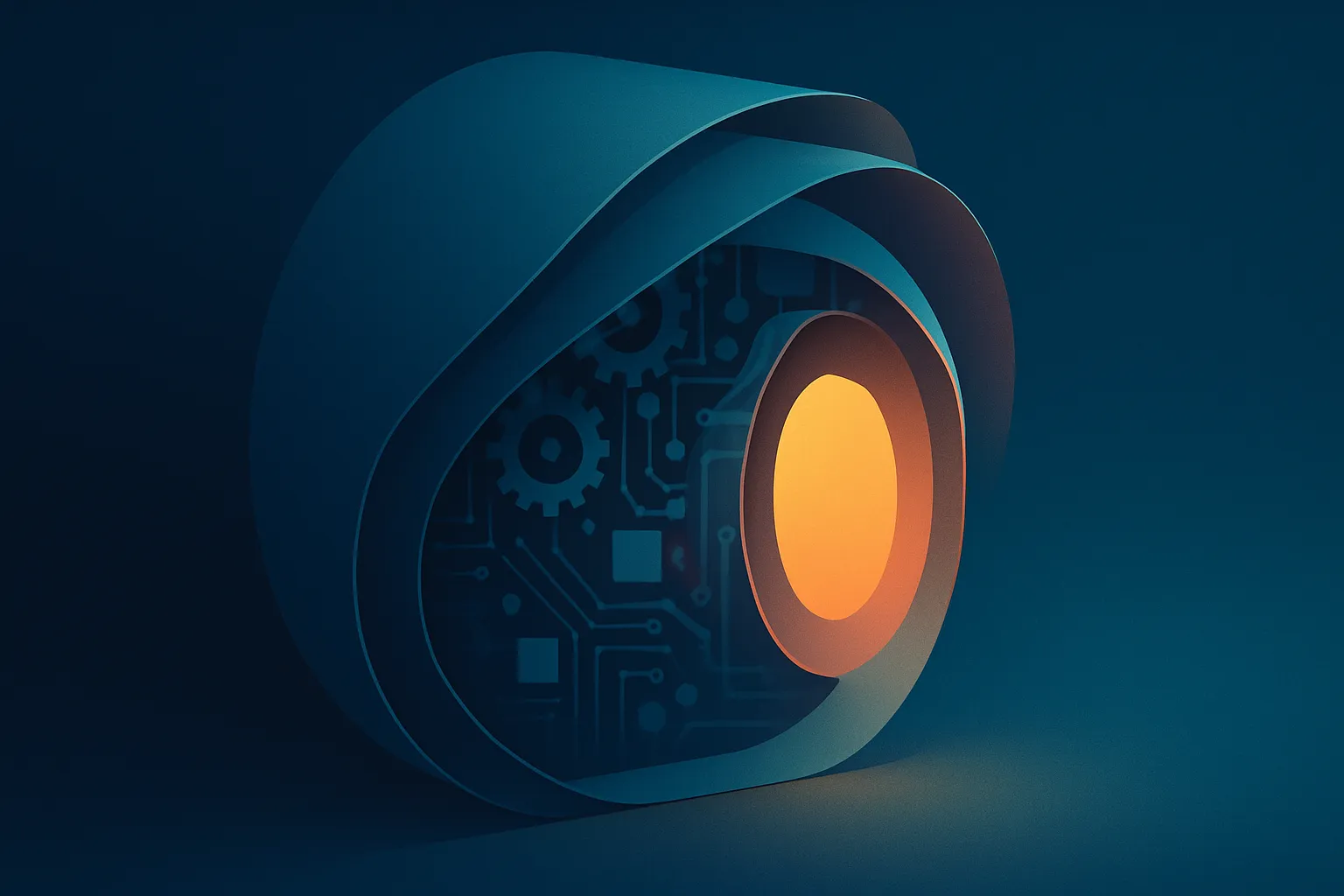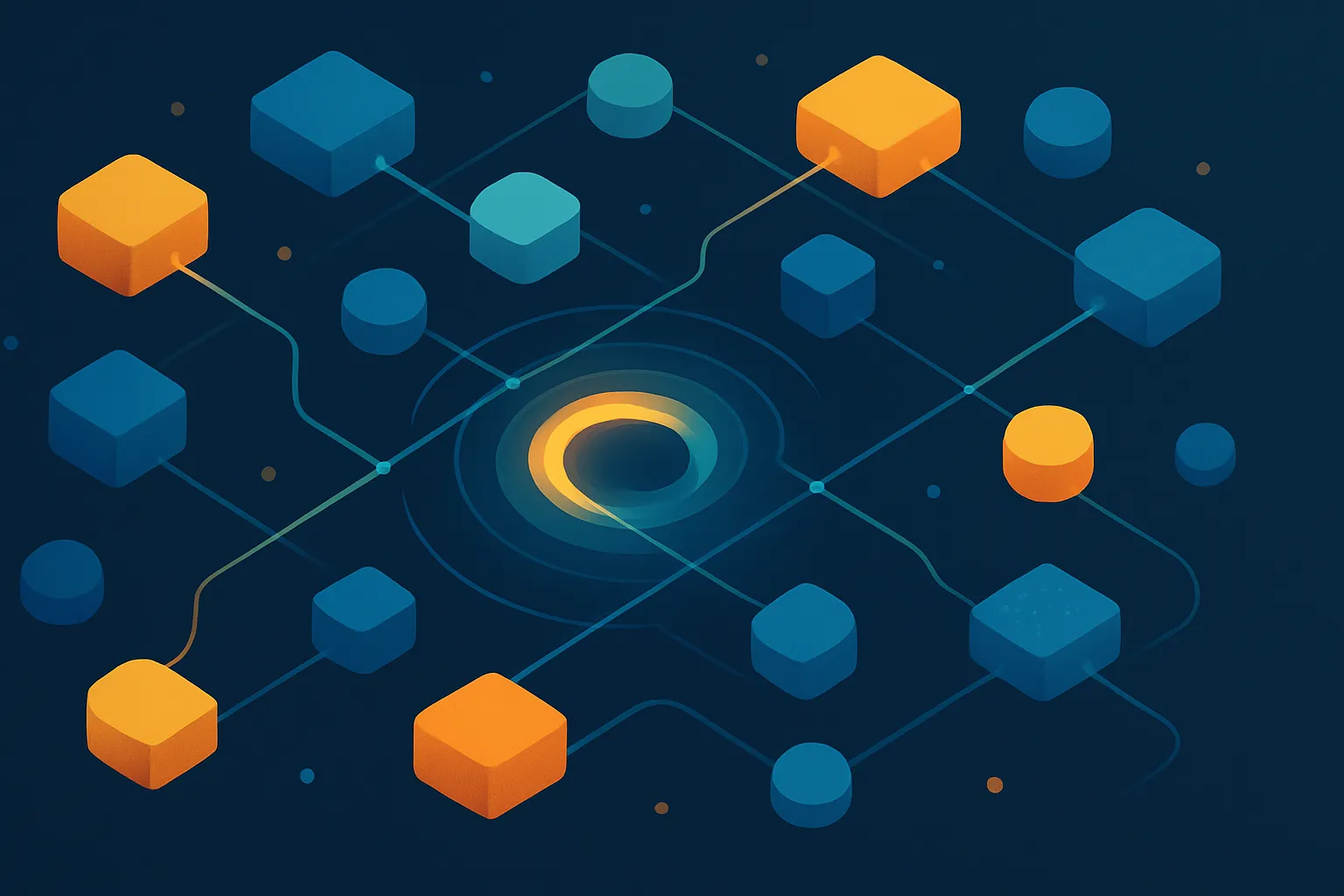
The Great Rewiring: A Product Builder's Guide to the Converging Tech Shifts Defining the Next Decade
Stop chasing the latest AI feature. You’re missing the tectonic plates shifting beneath your feet. While everyone debates the next LLM benchmark or the nuances of prompt engineering, a fundamental rewiring of our technological substrate is underway, driven by forces far more profound than incremental updates.1 The relentless fragmentation and rapid evolution across multiple fronts – artificial intelligence, the Internet of Things, decentralized systems, user experience, systems architecture – make it agonizingly difficult to discern the overarching pattern. Product builders, focused on optimizing the immediate, risk perfecting features for a world that is rapidly ceasing to exist, missing the emergence of entirely new paradigms.
This isn’t just another list of fleeting trends. This analysis argues that six pivotal technological shifts – the Autonomous Economy, Radical Abstraction, Modularity & Composability, Ecosystem Dynamics, Ambient & Continuous Intelligence, and Next-Gen UX – are not isolated phenomena. They are deeply interconnected forces, converging and co-evolving to forge a new foundational architecture for the digital world. The objective here is not mere prognostication, but to provide a conceptual framework, a mental model, for product builders navigating this complex transition. This vision, while forward-looking, is firmly grounded in observable technological vectors and current research trajectories, offering a strategic lens through which to view the future of product development.
The Six Threads of the Future Fabric
Understanding these shifts individually is the first step. Recognizing their interplay is the key to unlocking future value.
1. The Autonomous Economy: Machines Enter the Marketplace

We are witnessing a profound transition, moving beyond simple task automation towards the dawn of an Autonomous Economy. This isn’t merely about robots performing rote tasks; it’s about the emergence of autonomous economic agents – AI systems, IoT devices, and decentralized networks – capable of not just executing complex functions but also making independent economic decisions, owning assets, and transacting value directly with each other, machine-to-machine (M2M) or agent-to-agent.
The engine driving this shift is the rapid maturation of AI agents. These are no longer experimental tools but increasingly essential business assets, evolving from rule-based automation to intelligent entities that can handle ambiguity, adapt to changing conditions, learn from interactions, and operate autonomously across complex workflows. Enterprises are leveraging AI agents for everything from streamlining routine tasks and enhancing productivity to managing end-to-end workflows with minimal human input, such as financial forecasting, invoice processing, fraud detection, and IT ticket triage. The global AI agent market, valued around $5.4 billion in 2024, is projected to explode to $47.1 billion by 2030, with predictions suggesting 85% of enterprises will utilize AI agents by 2025. These agents are becoming independent decision-makers, capable of tasks previously reserved for humans, like assessing loan risks or even shortlisting job candidates.
Providing the physical nervous system for this economy is the Internet of Things (IoT). The sheer number of connected devices, forecasted to surpass 25 billion by 2030, creates a vast network of sensors and actuators interacting with the physical world. But the true paradigm shift occurs with the Economy of Things (EoT) – the convergence of IoT, AI, and Web3 technologies. In the EoT, connected devices (“things”) transcend their role as mere data conduits or tools; they become autonomous economic actors capable of monetizing the value they create.8 This is manifest in Decentralized Physical Infrastructure Networks (DePINs). DePINs utilize blockchain and token incentives to enable communities and machines to collectively build, operate, and own real-world physical infrastructure – think decentralized wireless networks, energy grids, sensor arrays, or mobility services. These networks form the physical substrate upon which autonomous agents can operate and transact.
The financial plumbing enabling these M2M transactions is Decentralized Value Exchange. Technologies like blockchain, smart contracts, and Decentralized Exchanges (DEXs) facilitate secure, transparent, and automated peer-to-peer (or agent-to-agent) value transfer without relying on traditional financial intermediaries. Smart contracts can automate economic interactions between devices, enabling them to buy and sell services, data, or resources directly. This trustless framework is essential for an economy where non-human agents participate actively.
Imagine… a world where your autonomous EV doesn’t just drive you, but actively participates in an energy market, negotiating charging prices with stations based on real-time grid load, selling excess battery capacity back during peak demand, and paying tolls directly via smart contracts – all without your intervention.
This confluence of AI agents, IoT/EoT/DePIN, and decentralized finance points towards a fundamental restructuring of economic activity. When AI agents gain decision-making autonomy, IoT devices provide the physical embodiment and data streams, and decentralized ledgers offer a trustless mechanism for value exchange, machines cease to be mere tools within the economy. They become potential participants, capable of M2M commerce and contributing to economic networks like DePINs. This necessitates rethinking market design, regulation, and even the definition of economic actors. Product builders must consider designing not just for human users, but for machine customers, partners, and competitors.
Furthermore, the DePIN model itself represents a significant shift. By leveraging token incentives to crowdsource the deployment and operation of physical infrastructure, DePINs offer a decentralized, potentially faster, and community-driven alternative to traditional, capital-intensive, centralized infrastructure development. If successful, this model could dramatically accelerate the build-out of the physical layer – the sensor networks, charging stations, communication relays – essential for the Autonomous Economy to function at scale. This creates fertile ground for new business models focused on contributing to, managing, or utilizing these decentralized networks, posing a direct challenge to incumbent infrastructure providers.
2. Radical Abstraction: Infinite Power, Deceptive Simplicity

Simultaneously, we are experiencing a wave of Radical Abstraction. Foundational technologies of immense complexity – Large Language Models (LLMs), sophisticated simulation engines, perhaps even future systems modeling reality’s fundamental laws – are being encapsulated within deceptively simple interfaces, primarily APIs and natural language prompts. The locus of value creation increasingly shifts towards these abstraction layers, which democratize access to unprecedented computational power while hiding the staggering underlying complexity.
LLMs are the quintessential example. These models, built on billions of parameters and trained on vast datasets, exhibit remarkable capabilities in language understanding and generation, yet they are accessed through straightforward text inputs or API calls. While their nature as sophisticated statistical pattern matchers rather than truly understanding entities must be acknowledged, their utility derived through abstraction is undeniable.
To better grasp these layers, the Language Model System Interface Model (LMSI) offers a useful framework, inspired by the OSI model in networking. LMSI delineates seven layers, ranging from direct interaction with the model’s neural network architecture and weights at the bottom, through layers for prompting and constraint application, up to the application and user layers at the top. This stratification clarifies how complexity is managed and functionality is exposed at different levels.
However, the inherent non-determinism of LLMs poses challenges for reliable integration into predictable workflows. This has spurred the development of ‘Controlled Generation’ frameworks like Guidance, LMQL, and Outlines. These act as crucial intermediate abstraction layers, providing mechanisms to constrain LLM outputs – enforcing specific formats, adhering to schemas, or following predefined logical paths – making LLMs more dependable components in larger systems.
Looking further ahead, concepts like Ontic AI propose an even more profound level of abstraction. Instead of modeling patterns in human-generated data, Ontic AI aims to model reality itself, grounding intelligence in physics, causality, and ontology. Such systems, if realized, would offer access not just to language capabilities, but to simulated or modeled aspects of reality, accessed through layers like a “Reality Interface” or “Causal Engine” – the ultimate abstraction.
What if… foundation models for complex scientific domains – like materials science discovery, drug interaction simulation, or climate modeling – were as accessible via simple APIs as LLMs are for text generation today? Imagine the explosion of innovation when domain expertise is radically democratized through abstraction.
When dealing with technologies of such immense underlying complexity, the primary means by which users and developers derive value is through the abstraction layer provided. The design, usability, and power of this interface – be it an API, a prompt structure, or a sophisticated control framework like LMSI or Ontic AI’s proposed layers – become critically important. Early success often hinges on perfecting this access layer. For product builders leveraging foundation models, the interface is the product, at least initially. Its design determines accessibility, control, and the user’s ability to harness the latent power within.
Moreover, these abstraction layers are key enablers of specialization and composability. By hiding the intricate details, abstractions allow developers to treat powerful models as functional building blocks. This modularity, facilitated by well-defined interfaces like APIs or controlled generation tools, is a fundamental prerequisite for the composable systems discussed next, where different abstracted capabilities can be seamlessly plugged together to create sophisticated applications. Radical Abstraction, therefore, directly fuels Modularity & Composability.
3. Modularity & Composability: The Lego Blocks of Innovation

The architectural paradigm is shifting decisively away from rigid, monolithic systems towards Modularity & Composability. This approach involves designing systems – encompassing software and potentially even hardware – from independent, interchangeable components, often termed Packaged Business Capabilities (PBCs). These components can be assembled, reconfigured, updated, and scaled independently, creating highly flexible and resilient systems. Think of it like building with LEGOs, adapting structures quickly as needs evolve.
This paradigm rests on four key principles, as articulated by Gartner:
- Modularity: The system comprises distinct, self-contained pieces, each serving a specific function (e.g., a payment processing module, a user authentication service).
- Autonomy: Individual components can be modified, updated, or replaced without breaking the entire system. Updating one module doesn’t necessitate a full system overhaul.
- Orchestration: Components are designed to communicate and share data seamlessly, often via APIs, enabling them to work together cohesively.
- Discovery: Available components are easily findable, understandable, and reusable across different applications or contexts.
A crucial technical enabler for composable architectures is the MACH framework: Microservices, API-first, Cloud-native, and Headless. Microservices provide the necessary granularity. An API-first approach ensures interoperability. Cloud-native infrastructure delivers scalability and agility. Headless architecture decouples the frontend presentation layer from backend logic, allowing for flexible, channel-specific user experiences. Together, MACH principles create an environment where composability can flourish across the entire stack – UI, API, data, and infrastructure.
The benefits are compelling. Composability drives agility, enabling organizations to respond rapidly to market shifts, deploy new features quickly, and iterate faster. It enhances resilience, as the failure of one component typically doesn’t bring down the entire system, reducing downtime and risk. It supports independent scalability of services based on demand. It fosters innovation by making it easier to experiment with new technologies and integrate best-of-breed solutions from different vendors. This approach also future-proofs systems, simplifying the adoption of emerging technologies. The momentum is clear: Gartner predicted that by 2025, 60% of new Manufacturing Execution Systems (MES) solutions would be assembled using composable technology. A prime example is the Cursor IDE, which leverages the VSCode platform (itself modular) and integrates various abstracted LLM capabilities as composable components.
Imagine… a manufacturing plant where production lines aren’t fixed monoliths. Instead, they are composed of modular robotic units, sensor packages, and software controllers. Need to switch products? Reconfigure the line by swapping modules in hours, not months. Need a new quality assurance step? Plug in a specialized AI vision module. This is the power of composability extending into the physical world.
In today’s rapidly evolving landscape, the ability to adapt quickly is not just an advantage; it’s a survival mechanism. Monolithic architectures inherently resist change, creating friction and slowing down innovation. Composable architectures, by design, minimize this friction, breaking down complex systems into manageable, independent parts. This grants organizations a fundamental competitive edge in speed and adaptability. Therefore, embracing composability is less an architectural choice and more a strategic imperative for navigating dynamic markets.
This shift also fundamentally alters how value is created. In the monolithic era, value resided in building and maintaining a single, large, integrated system. In the composable era, value increasingly comes from selecting the best individual components (PBCs) – whether built in-house or sourced externally – and skillfully orchestrating them into a cohesive and effective whole. The critical skill shifts from building everything to integrating effectively, defining robust interfaces (APIs being paramount), and managing the complex interplay between modules. This creates new opportunities for specialized component providers and expert integrators, demanding a strategic focus on orchestration rather than just construction.
4. Ecosystem Dynamics: The Gravity of Interconnection

No product is an island. Value creation is increasingly a function of Ecosystem Dynamics, occurring between entities – firms, software components, autonomous agents – within larger technological constellations, rather than solely within the confines of a single product or company. Navigating this reality requires mastering interdependencies, championing interoperability, cultivating network effects, and strategically engaging with the standards that govern these interactions.
Interoperability – the ability of different products, services, or systems to work together seamlessly despite differences in interface or implementation – is the lifeblood of healthy ecosystems. It encompasses both protocol interoperability (technical ability to exchange data) and data interoperability (ability to understand and use the exchanged data). Compatibility standards (like USB, Wi-Fi, TCP/IP, and potentially future standards for EoT or agent communication) are the crucial enablers of interoperability. They provide the common ground, the shared rules, that allow diverse components to connect, communicate, and create collective value, reducing friction and unlocking the ecosystem’s potential. However, establishing these standards is fraught with challenges, including technical complexity, economic maneuvering, and the difficulty of achieving social consensus among diverse stakeholders.
Standards and interoperability directly fuel network effects, the phenomenon where a product or service becomes more valuable as more people (or compatible components) use it. Classic examples include the telephone network, software platforms like Windows or Android, financial exchanges, and even cryptocurrencies. Strong network effects create powerful feedback loops, attracting more users and developers, further increasing the ecosystem’s value and often leading to dominant market positions.
Recognizing this power, firms actively engage in the strategic shaping of ecosystems. They compete within standards-setting organizations to influence the technical specifications (“rules of the game”) in ways that favor their own technologies and strategies. Success in this arena depends on a complex interplay of a firm’s relational influence (its network of partners and allies) and its technical position (whether its proposals impact core, highly interdependent parts of the ecosystem or more peripheral, complementary components). Navigating existing and future complementarities and managing interdependencies are key. Simultaneously, regulators are increasingly intervening, pushing for interoperability mandates (e.g., via the EU’s Digital Markets Act or Data Act) to foster competition and prevent gatekeeper dominance, highlighting the need for careful, possibly ecosystem-tailored, standardization approaches. The PyTorch ecosystem serves as a good illustration: a core framework surrounded by a rich network of interoperable libraries and tools, built on shared conventions, fostering strong network effects within the ML community.
What if… open standards for autonomous vehicle communication allowed any certified vehicle, regardless of manufacturer, to seamlessly share anonymized sensor data about road hazards or traffic flow, creating a collective real-time map far richer than any single company could build alone? The value isn’t in the individual car, but the interconnected ecosystem.
It’s crucial to understand that standards are rarely neutral technical artifacts; they are strategic battlegrounds. They embody design choices that inherently favor certain technologies, architectures, and business models over others. Because standards unlock interoperability and powerful network effects, controlling a key standard often equates to influencing the ecosystem’s trajectory and capturing disproportionate value. This makes standards development a critical arena for strategic competition. Product builders, particularly those creating foundational platforms or technologies, must actively participate in, influence, or at least strategically align with relevant standards bodies and ecosystem consortia. Ignoring this dimension is perilous.
This leads to a broader shift: competition is moving from the level of individual products to the level of entire ecosystems. When interoperability and network effects dominate, the best standalone product may lose to a slightly inferior one that is part of a more vibrant, interconnected ecosystem. Companies increasingly compete through their ecosystems, leveraging partners, complementors, and shared standards to build collective gravity. Product strategy must therefore explicitly address the ecosystem context: How does the product integrate? What value does it contribute to the ecosystem? How can it leverage existing network effects? How can it foster beneficial complementarities? Building sustainable competitive advantages now involves cultivating ecosystem gravity.
5. Ambient & Continuous Intelligence: The World as Interface

The nature of intelligence itself is transforming. We are moving beyond AI as an on-demand tool, summoned by a query or click, towards Ambient & Continuous Intelligence (AmI) – proactive, persistent intelligence woven into the fabric of our physical environments. This paradigm relies on continuous, real-time data streams ingested from ubiquitous sensors and IoT devices, processed intelligently (often at the network edge) to understand context, anticipate needs, and act autonomously to assist or optimize.
AmI operates on a continuous sense-process-respond cycle. First, sensors (cameras, microphones, wearables, environmental monitors) and IoT devices act as the system’s perceptual organs, constantly gathering raw data about the environment and its occupants. Second, AI and machine learning algorithms process this torrent of real-time data, identifying patterns, recognizing activities, understanding context (“who, what, where, when”), detecting anomalies, and predicting future states or needs.28 Third, based on this contextual understanding, the system responds proactively and often autonomously, adjusting environmental controls, triggering alerts, providing information, or automating tasks without explicit human commands.
The role of sensors and continuous real-time data is foundational. AmI systems are data-hungry, requiring persistent streams to maintain situational awareness and fuel their predictive capabilities. This dependence underscores the tight coupling between AmI and the proliferation of IoT.
Crucially, edge computing plays a vital role in making AmI practical and responsive. Processing data locally, closer to the sensors (“at the edge”), rather than sending everything to a centralized cloud, minimizes latency, enables near real-time decision-making, reduces bandwidth consumption, and can enhance data privacy and security by limiting the transmission of raw sensor data.
Applications are emerging across diverse domains: smart buildings adjusting lighting and HVAC based on occupancy; predictive maintenance systems monitoring industrial equipment health and scheduling repairs proactively; intelligent security systems detecting threats like perimeter breaches or unauthorized access in real-time; smart grids optimizing energy distribution; and healthcare platforms providing real-time patient monitoring and clinical decision support.
Imagine… walking into a meeting room. The room knows who’s present (via opt-in device recognition), anticipates the meeting’s purpose from calendars, automatically configures the AV equipment, adjusts lighting and temperature for comfort, and proactively surfaces relevant documents or data visualizations based on the ongoing conversation – all seamlessly, without a single click or command.
This represents a fundamental paradigm shift from reactive, command-driven AI (like current chatbots) to proactive, context-aware systems that operate persistently in the background. AmI systems continuously observe, learn, and act based on their understanding of the environment and user intent. This necessitates different system architectures heavily reliant on sensor networks and edge processing, as well as different AI capabilities focused on context modeling, prediction, and autonomous action. Product design must evolve beyond request-response interfaces to consider how users interact with, trust, and potentially override these proactive systems.
The “always-on” sensing nature of AmI, however, brings significant privacy and security challenges to the forefront. These systems require a constant influx of potentially sensitive environmental and personal data to function effectively. Unlike transactional data collection, AmI involves persistent environmental monitoring. Therefore, addressing privacy and security is not an optional add-on but a core requirement for building trustworthy and adoptable AmI products. Techniques like edge processing to minimize raw data transmission, robust data anonymization, strict data minimization principles, transparent user consent and control mechanisms, and compliance with regulations are essential design considerations from the outset.
6. Next-Gen UX: Talking to the Machine Mind

As AI systems become more complex, autonomous, multimodal, and potentially less human-like in their “reasoning” (driven by Radical Abstraction or participating in the Autonomous Economy), our current user experience (UX) paradigms – primarily Graphical User Interfaces (GUIs) and text-based chat – are proving insufficient. Interacting effectively with these emerging systems necessitates Next-Gen UX: higher-bandwidth, more intuitive, multimodal, adaptive, and potentially even direct neural interfaces.
The limitations are becoming apparent. Chat interfaces, while effective for certain tasks, struggle with complex, multi-step processes or managing systems with rich, dynamic state. GUIs, designed for direct manipulation of predictable software, can become cluttered and unwieldy when trying to represent and control complex, probabilistic, or autonomous systems. This leads to the “interface dilemma”: how to design effective interactions for sophisticated multimodal AI, balancing accessibility, input complexity, response accuracy, and system requirements across different modes like text, voice, video, and immersive environments.
The path forward likely involves multimodal interaction, seamlessly blending input and output modalities like voice, natural language text, gesture recognition, eye-tracking, spatial computing (Augmented Reality/Virtual Reality), and haptics to create richer, more context-aware, and natural dialogues between humans and machines. Voice interfaces, in particular, are rapidly maturing, aiming for truly conversational experiences.
Furthermore, AI itself can be leveraged to create adaptive and personalized interfaces. Imagine UIs that dynamically reconfigure themselves based on the user’s current task, context, expertise level, or even inferred emotional state. AI could proactively adjust layouts, surface relevant information, or modify interaction flows to optimize usability and effectiveness in real-time.
Pushing the boundaries further is the prospect of Brain-Computer Interfaces (BCIs). BCIs aim to establish a direct communication pathway between the human brain and external devices, bypassing traditional muscular pathways. The basic process involves acquiring neural signals (invasively or non-invasively), pre-processing them to remove noise, extracting relevant features, classifying these features to interpret user intent, and translating that intent into device control commands. AI is revolutionizing every stage of this process, from enhancing signal acquisition using high-resolution interfaces (like microelectrode arrays or advanced non-invasive sensors) and improving signal processing with deep learning and adaptive algorithms, to enabling more sophisticated control and providing richer sensory feedback. While invasive BCIs (like Neuralink’s focus) offer higher fidelity, non-invasive approaches (like Cognixion’s EEG-based headsets) prioritize accessibility and lower risk, initially targeting applications like communication aids for individuals with severe disabilities.
Imagine… managing a complex swarm of autonomous logistics drones not through a dashboard, but through a combination of voice commands for strategic direction, hand gestures within an Augmented Reality overlay visualizing their real-time status and projected paths, and perhaps even direct intent signals via a non-invasive BCI for high-stakes, time-critical maneuvers. The interface becomes a fluid, high-bandwidth extension of your cognitive process.
The evolution of interfaces is intrinsically linked to the evolution of the systems they control. Simple, deterministic software gave rise to the GUI. Language-centric AI popularized the chat interface. As AI becomes more autonomous, context-aware, and capable of processing multimodal information, the interfaces must co-evolve to match this complexity. They need to support richer forms of input, provide clearer visualizations of the AI’s state and intentions, enable more nuanced control, and adapt dynamically. This demands a shift in UX design thinking, moving towards multimodal interaction design, context-aware adaptation, and potentially even neuro-informed design principles for future BCI applications.
In this context, BCI represents the ultimate abstraction layer, but this time for human input. Just as Radical Abstraction simplifies access to complex AI for systems, BCI aims to simplify the expression of human intent, bypassing the indirection of keyboards, mice, or even voice commands to capture intent directly from neural signals. While significant challenges remain – signal quality, noise reduction, user training, bandwidth, and profound ethical considerations – the potential is transformative. It promises an incredibly high-bandwidth, intuitive connection between human thought and the increasingly complex digital and autonomous systems surrounding us. While mainstream adoption is distant, its progress warrants close attention, particularly for applications requiring nuanced control of complex systems or offering radical accessibility improvements.
The Convergence: Weaving the Threads Together

These six technological shifts – Autonomous Economy, Radical Abstraction, Modularity & Composability, Ecosystem Dynamics, Ambient & Continuous Intelligence, and Next-Gen UX – are not evolving in isolation. They are deeply intertwined, mutually reinforcing, and co-evolving, weaving together the fabric of a new technological reality. Understanding their convergence is critical for anticipating the future landscape.
Consider the synergies:
- The Autonomous Economy cannot function without Ambient Intelligence. Autonomous agents 3 require continuous, real-time data streams from sensors embedded in the environment 28 to perceive their surroundings, make informed decisions, and act effectively. Composability provides the architectural flexibility needed to deploy, connect, and update these agents and sensor networks efficiently.17
- Radical Abstraction provides the engine for both autonomous decision-making and ambient insight. Powerful foundation models 14 deliver the complex reasoning, prediction, and pattern recognition capabilities required by autonomous agents operating in dynamic environments 5 and are essential for extracting meaningful insights from the noisy, high-volume data streams generated by ambient sensors.28
- Ecosystem Dynamics provide the rules and pathways for autonomous value exchange. Standardized communication protocols and interoperable platforms 24 are indispensable for autonomous agents to discover each other, coordinate actions, and securely transact value within EoT and DePIN frameworks.8 Network effects within these ecosystems incentivize participation and drive adoption.25
- Next-Gen UX becomes the crucial control and collaboration layer for managing autonomous complexity. As swarms of agents, ambient systems, and radically abstracted AI proliferate, advanced interfaces – multimodal, spatial, adaptive, and perhaps eventually BCI-driven 34 – are necessary for effective human oversight, intervention, and human-agent teaming.
- Composability acts as the glue facilitating Ecosystem Integration. Modular components built with standard APIs 20 make it significantly easier for products and services to plug into larger ecosystems, contribute value, and benefit from established network effects 25, accelerating innovation across the ecosystem.
Taken together, these converging shifts point towards more than just incremental technological advancement. They suggest the emergence of a new computing paradigm. We are moving towards a world characterized by systems that are increasingly decentralized, autonomous, continuously context-aware, radically abstracted, inherently composable, and deeply interconnected through standardized protocols and governed by ecosystem dynamics, all interacted with via fundamentally new user experiences. An autonomous economy requires new decentralized infrastructure (DePIN) and interaction rules (standards). Radical abstraction changes what we can build and how we interact with complexity. Composability revolutionizes how systems are architected and evolved. Ambient intelligence fundamentally alters the relationship between computing and the physical world. Next-gen UX redefines the human-machine boundary. The convergence of these forces signals a potential phase transition in technology, perhaps as significant as the advent of the personal computer, the internet, or mobile and cloud computing.
Building on the New Foundation: A Mental Model for Product Leaders
The six converging shifts outlined above are not merely trends to track; they represent the pillars of a new technological foundation. For product leaders and strategists, understanding these shifts and, more importantly, their interplay, is crucial for navigating the coming decade. This analysis offers a conceptual framework, a mental model, to guide strategic thinking and product development in this evolving landscape.
To apply this framework, consider these critical questions for your product strategy, mapped to each converging shift:
- Autonomous Economy: How might our product participate in or enable machine-to-machine value exchange? Are there opportunities to leverage or contribute to emerging Decentralized Physical Infrastructure Networks? Who are our potential non-human users, customers, or partners?
- Radical Abstraction: What underlying complexities in our domain can we abstract away to empower users? Which foundation models (LLMs, simulation engines, etc.) can we leverage as core capabilities? How do we design the most effective and intuitive interface to this abstracted power?
- Modularity & Composability: How can we architect our product and systems using composable principles? Which capabilities should be developed as distinct PBCs versus integrated monolithically? How will a composable approach enhance our agility, resilience, and ability to innovate?
- Ecosystem Dynamics: Which technological ecosystems are most critical to our product’s success? How do we ensure seamless interoperability with key partners and platforms? What standards should we adopt, contribute to, or strategically influence? How can we leverage and contribute to network effects?
- Ambient & Continuous Intelligence: Could our product deliver significantly more value if it were continuously aware of its environment or user context? How can it transition from reactive responses to proactive assistance? How will we address the inherent privacy and security implications of continuous sensing from day one?
- Next-Gen UX: Is our current user interface adequate for the complexity our users need to manage, especially when interacting with AI or autonomous systems? Which multimodal inputs (voice, gesture, spatial) or adaptive UI techniques could create a more intuitive and powerful experience? What are the long-term implications of BCI advancements for our domain?
The following table provides a concise summary of this framework:
| Theme | Core Essence | Key Implication for Builders | Critical Question(s) |
|---|---|---|---|
| Autonomous Economy | Machines become economic actors transacting value via AI, IoT, & decentralized tech (EoT/DePIN). | Design for machine interactions & participation in new economic networks. | How does our product fit into M2M value chains or DePINs? |
| Radical Abstraction | Immense complexity (LLMs, simulations) hidden behind simple interfaces (APIs, NL). | Focus on the interface/API as the product; leverage powerful abstracted capabilities. | What can we abstract? How do we expose it effectively? |
| Modularity & Composability | Systems built from independent, interchangeable, reusable components (PBCs). | Adopt modular design for agility, resilience, and faster innovation cycles. | How can we make our system composable? Build vs. buy PBCs? |
| Ecosystem Dynamics | Value created via interoperability, standards, and network effects between entities. | Compete through ecosystems; strategically engage with standards and partners. | Which ecosystem? How to ensure interoperability & leverage network effects? |
| Ambient & Continuous Intelligence | Proactive, always-on AI using real-time sensor data & edge processing. | Shift from reactive to proactive, context-aware products; prioritize privacy. | How can our product become ambient/proactive? How to ensure trust/privacy? |
| Next-Gen UX | Moving beyond GUI/chat to multimodal, adaptive, high-bandwidth interfaces (voice, spatial, BCI). | Design interfaces adequate for AI complexity and new interaction modalities. | Is our UX sufficient? How can multimodal/BCI enhance interaction? |
Adopting this framework requires a strategic mindset shift. It demands thinking holistically about how these forces interact, prioritizing adaptability and resilience through composability, focusing on integration and interoperability within ecosystems, and recognizing that the nature of intelligence, economic interaction, and human-computer interfaces are all undergoing fundamental change. Success will come not from optimizing isolated features, but from understanding and building for this interconnected, emerging technological fabric.
Conclusion: The Future is Composable (and Autonomous, and Ambient…)

The technological landscape is being fundamentally rewired. The Autonomous Economy, Radical Abstraction, Modularity & Composability, Ecosystem Dynamics, Ambient & Continuous Intelligence, and Next-Gen UX are not disparate trends but converging currents forging a new reality. They promise a future where intelligent agents transact autonomously in decentralized networks, where unimaginable complexity is accessed through simple interfaces, where systems are built like adaptable Lego structures, where value flows through interconnected ecosystems, where intelligence is proactively embedded in our environment, and where we interact with technology in ways that were recently science fiction.
The products and platforms that define the next decade will not merely incorporate elements of AI or IoT; they will be native to this interconnected, autonomous, ambient, and composable fabric. Continuing to build for yesterday’s monolithic, centralized, reactive, and GUI-centric architecture is a strategy destined for obsolescence. The challenge for product leaders is clear: Are you ready to rewire your thinking and build for the architecture of tomorrow? Use this framework to question your assumptions, re-evaluate your roadmaps, and position your products not just to survive, but to thrive in the great rewiring. Understanding the synergies between these powerful shifts is the essential first step towards building truly transformative products for the future that awaits.
Related Posts
Why Your ML Infrastructure Choices Create (or Kill) Momentum
How early architectural decisions create a flywheel effect that accelerates rather than hinders your path to production. Discover the Nimble Flywheel framework for scaling ML from prototype to production.
When (and How) to Invest in MLOps at Your Startup
A practical guide for startup founders on when and how to invest in MLOps - from early stage flexibility to scaling infrastructure, with key principles and pitfalls to avoid.
Building Tech Products for India: A First-Principles Playbook
Explore why building tech for India means rethinking everything from the ground up—addressing local habits, scale, price sensitivity, and cultural diversity with first-principles design.